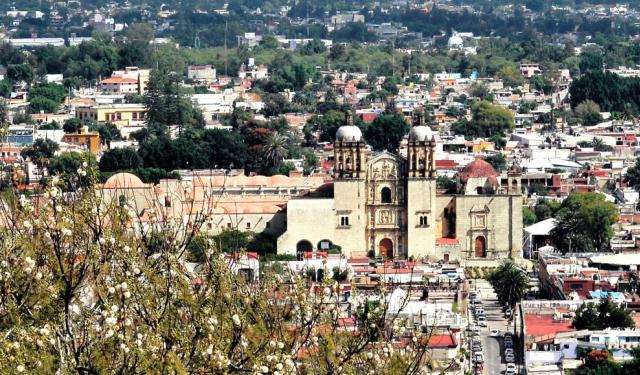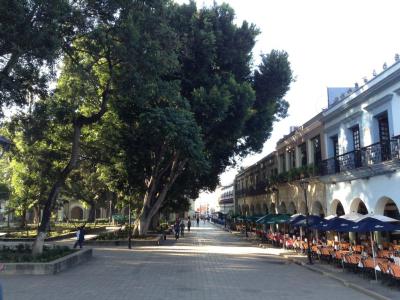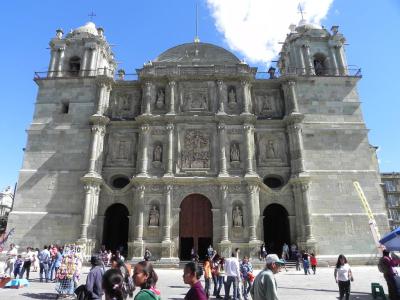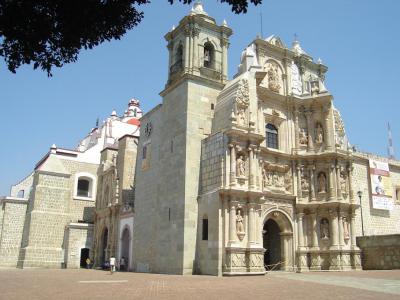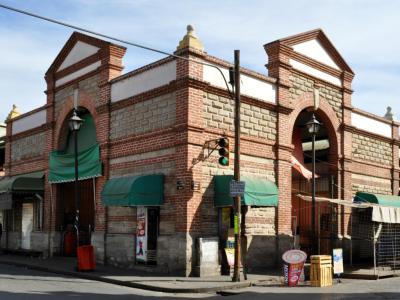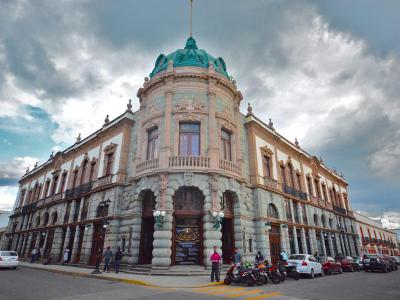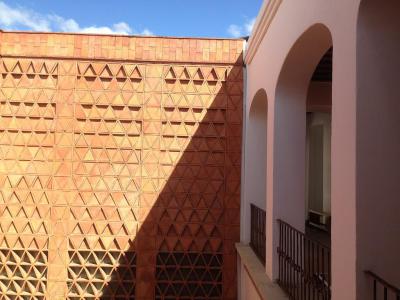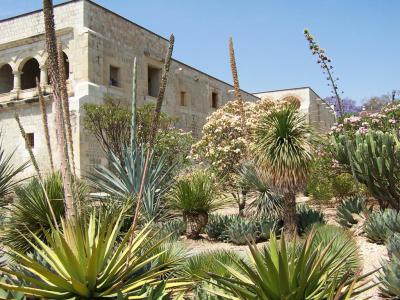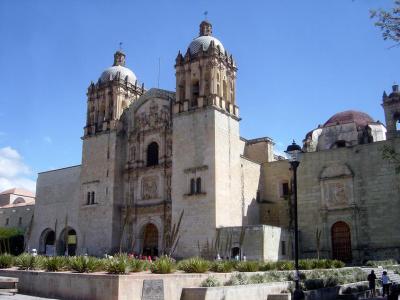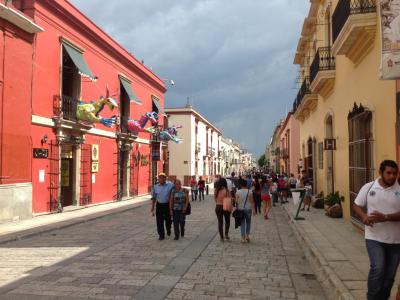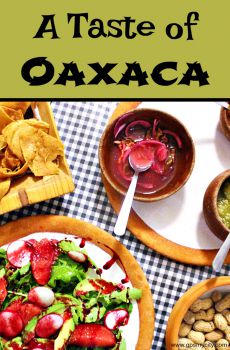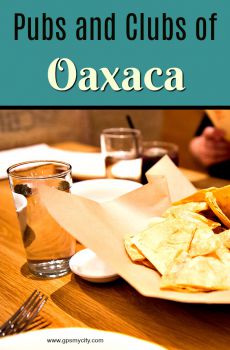Audio Guide: Oaxaca Introduction Walking Tour (Self Guided), Oaxaca
If cities could dance, Oaxaca would move to a slow, graceful rhythm-equal parts ancient pulse and everyday joy. Officially called Oaxaca de Juárez, this southern Mexican capital is where cultures don’t just meet-they throw a fiesta. You’ll find indigenous roots running deep, wrapped in colonial charm and topped with some of the best mole sauce you’ll ever taste.
Long before the Spanish showed up in 1532 with blueprints and armor, this land was known as an indigenous word that roughly translates to “on the nose of the huaje tree.” The pronunciation eventually took a detour and landed at “Oaxaca,” pronounced wah-HAH-kah (meaning "you’re welcome"). Since then, the city’s been a crossroads of civilizations, uprisings, and flavor.
You can feel that energy at the Zócalo, the city’s main square, where marimbas, a type of xylophone, echo under shade trees and balloon sellers float through the crowd. Towering over it all is the Cathedral of Our Lady of the Assumption, a Baroque beauty that’s weathered more quakes than we’ve had tacos. A short stroll away, the Basilica of Our Lady of Solitude offers a quieter kind of grandeur-and a front-row seat to Oaxacan devotion.
When your stomach starts chiming in, Benito Juárez Market answers with Mexican pizzas, grasshoppers (yes, really), and more mole sauce varieties than you thought possible. Walk it off along Macedonio Alcalá Street, a pedestrian-friendly stretch lined with galleries, bookshops, and color-drenched buildings that seem custom-made for your Instagram.
Culture admirers, prepare to swoon. The Macedonio Alcalá Theatre, a neoclassical stunner from the early 1900s, still puts on a show, whether or not the curtains are up. Just a few blocks away, the Oaxaca Textile Museum weaves together centuries of tradition in vibrant thread. Wait, there's more. The Ethnobotanical Garden is living proof that native plants know how to tell a story-especially when they grow beside a former monastery.
And speaking of that monastery: the Church of Saint Domingo of Guzmán is dripping in gold leaf, while the Museum of Oaxacan Cultures next door holds treasures from ancient tombs to contemporary art.
They say that whoever visits, always comes back. But just in case you’re the rare exception, take our self-guided walking tour. Oaxaca’s streets are ready for you, your appetite, and your camera.
Long before the Spanish showed up in 1532 with blueprints and armor, this land was known as an indigenous word that roughly translates to “on the nose of the huaje tree.” The pronunciation eventually took a detour and landed at “Oaxaca,” pronounced wah-HAH-kah (meaning "you’re welcome"). Since then, the city’s been a crossroads of civilizations, uprisings, and flavor.
You can feel that energy at the Zócalo, the city’s main square, where marimbas, a type of xylophone, echo under shade trees and balloon sellers float through the crowd. Towering over it all is the Cathedral of Our Lady of the Assumption, a Baroque beauty that’s weathered more quakes than we’ve had tacos. A short stroll away, the Basilica of Our Lady of Solitude offers a quieter kind of grandeur-and a front-row seat to Oaxacan devotion.
When your stomach starts chiming in, Benito Juárez Market answers with Mexican pizzas, grasshoppers (yes, really), and more mole sauce varieties than you thought possible. Walk it off along Macedonio Alcalá Street, a pedestrian-friendly stretch lined with galleries, bookshops, and color-drenched buildings that seem custom-made for your Instagram.
Culture admirers, prepare to swoon. The Macedonio Alcalá Theatre, a neoclassical stunner from the early 1900s, still puts on a show, whether or not the curtains are up. Just a few blocks away, the Oaxaca Textile Museum weaves together centuries of tradition in vibrant thread. Wait, there's more. The Ethnobotanical Garden is living proof that native plants know how to tell a story-especially when they grow beside a former monastery.
And speaking of that monastery: the Church of Saint Domingo of Guzmán is dripping in gold leaf, while the Museum of Oaxacan Cultures next door holds treasures from ancient tombs to contemporary art.
They say that whoever visits, always comes back. But just in case you’re the rare exception, take our self-guided walking tour. Oaxaca’s streets are ready for you, your appetite, and your camera.
How it works: Download the app "GPSmyCity: Walks in 1K+ Cities" from Apple App Store or Google Play Store to your mobile phone or tablet. The app turns your mobile device into a personal tour guide and its built-in GPS navigation functions guide you from one tour stop to next. The app works offline, so no data plan is needed when traveling abroad.
Oaxaca Introduction Walking Tour Map
Guide Name: Oaxaca Introduction Walking Tour
Guide Location: Mexico » Oaxaca (See other walking tours in Oaxaca)
Guide Type: Self-guided Walking Tour (Sightseeing)
# of Attractions: 9
Tour Duration: 2 Hour(s)
Travel Distance: 3.4 Km or 2.1 Miles
Author: DanaOffice
Sight(s) Featured in This Guide:
Guide Location: Mexico » Oaxaca (See other walking tours in Oaxaca)
Guide Type: Self-guided Walking Tour (Sightseeing)
# of Attractions: 9
Tour Duration: 2 Hour(s)
Travel Distance: 3.4 Km or 2.1 Miles
Author: DanaOffice
Sight(s) Featured in This Guide:
- Zocalo (Main Square)
- Catedral Metropolitana de Nuestra Senora de la Asuncion (Cathedral of Our Lady of the Assumption)
- Basilica de Nuestra Senora de la Soledad (Basilica of Our Lady of Solitude)
- Mercado Benito Juarez (Benito Juarez Market)
- Teatro Macedonio Alcala (Macedonio Alcala Theater)
- Museo Textil de Oaxaca (Oaxaca Textile Museum)
- Jardin Etnobotanico de Oaxaca (Oaxaca Ethnobotanical Garden)
- Church of Santo Domingo de Guzman and Museum of Oaxacan Cultures
- Andador de Macedonia Alcala (Macedonio Alcala Street)
1) Zocalo (Main Square) (must see)
Welcome to the beating heart of Oaxaca-the Zócalo-where history naps under the shade of laurel trees and marimbas provide the unofficial soundtrack. If you’re looking for the city’s social switchboard, you’ve found it.
This plaza has seen it all-ceremonies, revolutions, parades, protests, puppet shows, and impromptu salsa dancing. Though officially renamed The Constitution Square in honor of the 1812 Cádiz Constitution, nobody really bothered with the paperwork-“Zócalo” stuck, and so did its place in local lore.
In colonial times, this square became the setting for official ceremonies-where Spanish authorities made announcements, held military gatherings, and welcomed new rulers with plenty of ceremony. Today, it’s still the heart of public life. Religious traditions like Holy Week and Corpus Christi bring color and devotion to its streets, and if there's a national celebration-or a national frustration-it often starts here.
These days, it’s less powdered wigs, more piñatas. Picture an open-air living room framed by the Oaxaca Cathedral and Government Palace, filled with blooming gardens, iron benches, and a steady supply of street snacks. No matter what you're craving, there’s a vendor or a patio chair with your name on it.
One moment it’s a stage, the next a soapbox, and by evening it’s a dance floor-the Zócalo keeps Oaxaca’s heartbeat loud and steady.
This plaza has seen it all-ceremonies, revolutions, parades, protests, puppet shows, and impromptu salsa dancing. Though officially renamed The Constitution Square in honor of the 1812 Cádiz Constitution, nobody really bothered with the paperwork-“Zócalo” stuck, and so did its place in local lore.
In colonial times, this square became the setting for official ceremonies-where Spanish authorities made announcements, held military gatherings, and welcomed new rulers with plenty of ceremony. Today, it’s still the heart of public life. Religious traditions like Holy Week and Corpus Christi bring color and devotion to its streets, and if there's a national celebration-or a national frustration-it often starts here.
These days, it’s less powdered wigs, more piñatas. Picture an open-air living room framed by the Oaxaca Cathedral and Government Palace, filled with blooming gardens, iron benches, and a steady supply of street snacks. No matter what you're craving, there’s a vendor or a patio chair with your name on it.
One moment it’s a stage, the next a soapbox, and by evening it’s a dance floor-the Zócalo keeps Oaxaca’s heartbeat loud and steady.
2) Catedral Metropolitana de Nuestra Senora de la Asuncion (Cathedral of Our Lady of the Assumption) (must see)
Now that’s a name with flair. This isn’t just any church-it’s the spiritual heavyweight of Oaxaca’s Roman Catholic Archdiocese, and it’s been through a lot of shake-ups.
Construction kicked off in 1535, but things didn’t go smoothly. Earthquakes had other plans, turning the building process into a centuries-long game of architectural whack-a-mole. After several rebuilds, the version you’re seeing today finally wrapped up in 1733, standing proud in green cantera stone-a signature look in Oaxaca’s architectural wardrobe.
Step inside and you'll find elegant Neoclassical bones and an altar starring the Virgin Mary herself. That statue was handcrafted in Italy, accompanied by a bronze sculpture, because apparently when it comes to cathedral decor, only fine European imports will do.
While the original towers were toppled by the 1931 earthquake, there are still treasures tucked inside. The south wing boasts a clock sent over by Spain’s King Fernando VII. Over in the chapels, keep an eye out for the Lord of Lightning, who sounds like a Marvel character but is actually a venerated image, and the Cross of Huatulco, which has its own legend.
Oh-and that majestic pipe organ along the choir wall? It’s been around since 1711 and got a second wind in the '90s thanks to a full restoration. Play it loud, play it proud.
Think of it as Oaxaca’s greatest multitasker: sheltering saints, guarding relics, and stealing the spotlight in every skyline shot.
Construction kicked off in 1535, but things didn’t go smoothly. Earthquakes had other plans, turning the building process into a centuries-long game of architectural whack-a-mole. After several rebuilds, the version you’re seeing today finally wrapped up in 1733, standing proud in green cantera stone-a signature look in Oaxaca’s architectural wardrobe.
Step inside and you'll find elegant Neoclassical bones and an altar starring the Virgin Mary herself. That statue was handcrafted in Italy, accompanied by a bronze sculpture, because apparently when it comes to cathedral decor, only fine European imports will do.
While the original towers were toppled by the 1931 earthquake, there are still treasures tucked inside. The south wing boasts a clock sent over by Spain’s King Fernando VII. Over in the chapels, keep an eye out for the Lord of Lightning, who sounds like a Marvel character but is actually a venerated image, and the Cross of Huatulco, which has its own legend.
Oh-and that majestic pipe organ along the choir wall? It’s been around since 1711 and got a second wind in the '90s thanks to a full restoration. Play it loud, play it proud.
Think of it as Oaxaca’s greatest multitasker: sheltering saints, guarding relics, and stealing the spotlight in every skyline shot.
3) Basilica de Nuestra Senora de la Soledad (Basilica of Our Lady of Solitude)
If churches could sigh dramatically, the Basilica of Our Lady of Solitude would do it with style. Built between 1682 and 1690, this baroque beauty honors Our Lady of Solitude-Oaxaca’s patron saint and a figure so revered, she might deserve two basilicas.
The whole thing got started thanks to Father Fernando Méndez in 1690. But wait-like any true diva, the basilica wasn’t done with its glow-up. In the early 1700s, another bishop helped spruce things up with the elegant façade we see today.
Now, this isn’t your average church shape-it’s modeled after a Latin cross and built to stand strong when the ground starts to rumble. Earthquake-resistant architecture was no accident. The builders kept the towers low and sturdy, not sky-high and shaky. And that soft green stone? It’s cantera, Oaxaca’s signature building material, giving the whole place a local flair with a mineral glow.
Step inside and you’ll find the show-stealer: a baroque pipe organ from 1686, perched in the west gallery like it’s been waiting centuries for its next solo. Restored in 2000, it’s now back in tune and ready to provide heavenly ambiance for the devout and curious alike.
Part sanctuary, part architectural masterclass, the Basilica is a cornerstone of Oaxaca’s UNESCO-listed historic center, and a place where silence speaks volumes.
The whole thing got started thanks to Father Fernando Méndez in 1690. But wait-like any true diva, the basilica wasn’t done with its glow-up. In the early 1700s, another bishop helped spruce things up with the elegant façade we see today.
Now, this isn’t your average church shape-it’s modeled after a Latin cross and built to stand strong when the ground starts to rumble. Earthquake-resistant architecture was no accident. The builders kept the towers low and sturdy, not sky-high and shaky. And that soft green stone? It’s cantera, Oaxaca’s signature building material, giving the whole place a local flair with a mineral glow.
Step inside and you’ll find the show-stealer: a baroque pipe organ from 1686, perched in the west gallery like it’s been waiting centuries for its next solo. Restored in 2000, it’s now back in tune and ready to provide heavenly ambiance for the devout and curious alike.
Part sanctuary, part architectural masterclass, the Basilica is a cornerstone of Oaxaca’s UNESCO-listed historic center, and a place where silence speaks volumes.
4) Mercado Benito Juarez (Benito Juarez Market) (must see)
Benito Juárez Market is one of Oaxaca’s liveliest hubs-a maze of colors, scents, and sounds that pulls you right into the city’s daily rhythm. Named after Benito Juárez, a key figure in Mexican history and a native of Oaxaca, this market is as much about culture and community as it is about commerce.
Step inside and the energy hits instantly. Narrow passageways wind between stalls bursting with fresh produce, fragrant spices, handmade crafts, and souvenirs. Everywhere you look, something’s calling your attention-brightly stacked mangoes, avocados, and papayas; bunches of cilantro and Mexican tea leaves scenting the air. Much of it comes straight from nearby farms and villages, proudly displayed by the growers themselves.
The deeper you go, the more the aromas pull you toward the food stalls. Here’s where the market’s kitchen comes alive-griddles sizzling, steam rising, and flavors tempting from every corner. You’ll find tlayudas - which are large, crispy tortillas topped with beans, cheese, and all sorts of toppings - along with tamales, empanadas, and rich, complex mole, the sauce Oaxaca is famous for.
But food is just half the story. This is also a showcase for Oaxaca’s artisans. Woven rugs and tapestries hang beside hand-painted pottery, embroidered blouses, and carved wooden figurines. Every piece speaks of tradition and the kind of craftsmanship that takes years to master.
For locals, this market is more than a shopping trip-it’s a place to meet friends, swap news, and keep community ties strong. Voices mingle with the calls of vendors and the occasional burst of live music. And if you leave empty-handed, don’t worry-you’ll still carry the smell of roasted chiles and fresh tortillas with you, like the market’s way of saying, “See you next time.”
Step inside and the energy hits instantly. Narrow passageways wind between stalls bursting with fresh produce, fragrant spices, handmade crafts, and souvenirs. Everywhere you look, something’s calling your attention-brightly stacked mangoes, avocados, and papayas; bunches of cilantro and Mexican tea leaves scenting the air. Much of it comes straight from nearby farms and villages, proudly displayed by the growers themselves.
The deeper you go, the more the aromas pull you toward the food stalls. Here’s where the market’s kitchen comes alive-griddles sizzling, steam rising, and flavors tempting from every corner. You’ll find tlayudas - which are large, crispy tortillas topped with beans, cheese, and all sorts of toppings - along with tamales, empanadas, and rich, complex mole, the sauce Oaxaca is famous for.
But food is just half the story. This is also a showcase for Oaxaca’s artisans. Woven rugs and tapestries hang beside hand-painted pottery, embroidered blouses, and carved wooden figurines. Every piece speaks of tradition and the kind of craftsmanship that takes years to master.
For locals, this market is more than a shopping trip-it’s a place to meet friends, swap news, and keep community ties strong. Voices mingle with the calls of vendors and the occasional burst of live music. And if you leave empty-handed, don’t worry-you’ll still carry the smell of roasted chiles and fresh tortillas with you, like the market’s way of saying, “See you next time.”
5) Teatro Macedonio Alcala (Macedonio Alcala Theater)
Ready to feel fancy? Let’s step into Macedonio Alcalá Theater, Oaxaca’s glittering jewel box. Smack in the city center, this architectural stunner has been dazzling audiences since 1909-and it still got it.
It all kicked off in 1903 when plans were drawn up for a show-stopping venue that could impress even the most monocle-wearing critics of the day. Construction began in 1904 under engineer Rodolfo Franco, who clearly had a flair for drama-in the best way. Six years later, Oaxaca finally got its grand opening, and what an entrance it made.
Originally christened the Luis Mier, it went through a bit of an identity crisis-like many stars do-before settling in the 1930s on the name we know today: Macedonio Alcalá, in honor of the beloved Oaxacan composer who gave the world the soul-stirring waltz “God Never Dies”.
Now, let’s talk style. The building blends elegant curves and decorative details with a touch of old-school French luxury. The entrance greets you with three green stone arches, just subtle enough to say “elegant,” but bold enough to make anyone stop for a second. Inside, it’s classic Louis XV elegance-white marble staircases, ornate detailing, and a ceiling that leaves no doubt: this is a place that takes art seriously. Overhead, a sweeping allegory known as the Temple of Art features Fame and Reward in full dramatic flair-like a visual pep talk for anyone who dares to dream big on its stage.
Step inside for a performance, and you’re not just in the audience-you’re part of a century-old tradition of applause.
It all kicked off in 1903 when plans were drawn up for a show-stopping venue that could impress even the most monocle-wearing critics of the day. Construction began in 1904 under engineer Rodolfo Franco, who clearly had a flair for drama-in the best way. Six years later, Oaxaca finally got its grand opening, and what an entrance it made.
Originally christened the Luis Mier, it went through a bit of an identity crisis-like many stars do-before settling in the 1930s on the name we know today: Macedonio Alcalá, in honor of the beloved Oaxacan composer who gave the world the soul-stirring waltz “God Never Dies”.
Now, let’s talk style. The building blends elegant curves and decorative details with a touch of old-school French luxury. The entrance greets you with three green stone arches, just subtle enough to say “elegant,” but bold enough to make anyone stop for a second. Inside, it’s classic Louis XV elegance-white marble staircases, ornate detailing, and a ceiling that leaves no doubt: this is a place that takes art seriously. Overhead, a sweeping allegory known as the Temple of Art features Fame and Reward in full dramatic flair-like a visual pep talk for anyone who dares to dream big on its stage.
Step inside for a performance, and you’re not just in the audience-you’re part of a century-old tradition of applause.
6) Museo Textil de Oaxaca (Oaxaca Textile Museum)
If you think fabric’s just for curtains and cardigans-think again. Welcome to the Oaxaca Textile Museum, where threads have stories, weaves have histories, and patterns might just blow your mind.
Right in the heart of Oaxaca’s Historic Center, the museum is tucked inside Antelo House, a building with more costume changes than a telenovela star. It started life in the 16th century as part of the orchard for the Saint Pablo Convent, then became a farm, then a fancy earthen home, then a two-story upgrade. In the 19th century, it moonlighted as The Belen Hospital. Finally, in 2008, it was given a new purpose thanks to restoration efforts.
Today, the museum goes far beyond simply showing textiles-it celebrates them like masterpieces. With about 7,000 pieces in its care (yes, seven thousand), it treats fabric with the same reverence you’d give to fine art. And frankly, it earns that status. You’ll find everything from feather-threaded huipil fragments (that’s a traditional indigenous blouse) to richly woven sashes and ceremonial belts collected from across Mexico-and far beyond.
Exhibits invite you to get lost in the textures, patterns, and quiet rhythm of weaving. They also encourage you to notice the surprising links-a Zapotec shawl might share a motif with a textile from Southeast Asia. Threads, after all, travel.
So if you think “fiber arts” sounds a little too quiet-this museum will prove otherwise. Prepare to be dazzled by what a few skilled hands, a loom, and centuries of cultural memory can do.
Right in the heart of Oaxaca’s Historic Center, the museum is tucked inside Antelo House, a building with more costume changes than a telenovela star. It started life in the 16th century as part of the orchard for the Saint Pablo Convent, then became a farm, then a fancy earthen home, then a two-story upgrade. In the 19th century, it moonlighted as The Belen Hospital. Finally, in 2008, it was given a new purpose thanks to restoration efforts.
Today, the museum goes far beyond simply showing textiles-it celebrates them like masterpieces. With about 7,000 pieces in its care (yes, seven thousand), it treats fabric with the same reverence you’d give to fine art. And frankly, it earns that status. You’ll find everything from feather-threaded huipil fragments (that’s a traditional indigenous blouse) to richly woven sashes and ceremonial belts collected from across Mexico-and far beyond.
Exhibits invite you to get lost in the textures, patterns, and quiet rhythm of weaving. They also encourage you to notice the surprising links-a Zapotec shawl might share a motif with a textile from Southeast Asia. Threads, after all, travel.
So if you think “fiber arts” sounds a little too quiet-this museum will prove otherwise. Prepare to be dazzled by what a few skilled hands, a loom, and centuries of cultural memory can do.
7) Jardin Etnobotanico de Oaxaca (Oaxaca Ethnobotanical Garden)
Tucked behind the golden stone of the Saint Domingo Temple, where monks once strolled and the Mexican army later drilled for over a century, the Oaxaca Ethnobotanical Garden is proof that a parking lot doesn’t always win. When the army left in 1994, the state’s big idea was luxury suites and a car park-until artist Francisco Toledo and a band of determined locals lobbied for something greener. They got it. By 1998, the gates opened to a living, breathing snapshot of Oaxaca’s astonishing biodiversity.
Here, every leaf, petal, and spine has roots in Oaxaca’s soil. Agaves and cacti rescued from bulldozers now stand tall in the “save zone,” while medicinal plants like mesquite and fragrant copal whisper centuries-old remedies and rituals. The agave gets star billing-not just for its beauty, but because it fuels the state’s signature spirit, mezcal. A whole section is devoted to traditional food crops: corn, beans, amaranth, chia, tomatoes, yam, and chepil, the herb that gives tamales de chepil their distinct flavor.
The garden unfolds like a map of the state-dry desert corners prickling with succulents, shaded paths thick with tropical greens, and open plots that smell like someone’s cooking with fresh herbs nearby. Drum roll for the backdrop. The soaring Baroque walls of Saint Domingo and, beyond them, the mountains that feed the region’s microclimates. It’s more than a botany lesson-it’s a crash course in how landscape shapes culture, cuisine, and craft.
By the time you leave, you might not remember every Latin plant name, but you’ll remember the feeling: that in this city, history isn’t just carved in stone-it feeds the plants as they shoot towards the sun in front of you.
Here, every leaf, petal, and spine has roots in Oaxaca’s soil. Agaves and cacti rescued from bulldozers now stand tall in the “save zone,” while medicinal plants like mesquite and fragrant copal whisper centuries-old remedies and rituals. The agave gets star billing-not just for its beauty, but because it fuels the state’s signature spirit, mezcal. A whole section is devoted to traditional food crops: corn, beans, amaranth, chia, tomatoes, yam, and chepil, the herb that gives tamales de chepil their distinct flavor.
The garden unfolds like a map of the state-dry desert corners prickling with succulents, shaded paths thick with tropical greens, and open plots that smell like someone’s cooking with fresh herbs nearby. Drum roll for the backdrop. The soaring Baroque walls of Saint Domingo and, beyond them, the mountains that feed the region’s microclimates. It’s more than a botany lesson-it’s a crash course in how landscape shapes culture, cuisine, and craft.
By the time you leave, you might not remember every Latin plant name, but you’ll remember the feeling: that in this city, history isn’t just carved in stone-it feeds the plants as they shoot towards the sun in front of you.
8) Church of Santo Domingo de Guzman and Museum of Oaxacan Cultures (must see)
The Church and former Convent of Saint Domingo of Guzmán is a Baroque beauty that’s seen centuries of devotion, drama, and a few identity crises. The story kicks off in 1551, when the city council handed over twenty-four plots of land to the Dominican Order, that was founded by Saint Domingo of Guzman. Ambitious plans were drawn, but patience was key: the complex didn’t open its doors until 1608. Good things take time.
Over the years, Santo Domingo’s quiet halls saw some loud changes. During the 19th century, when church and state were clashing across Mexico, the building was taken over by the military. Worship was paused, pews were pushed aside, and the former convent spent a stretch of time serving as a warehouse and even a stable. It took a bit of political finesse-courtesy of Oaxacan-born president Porfirio Díaz-to return the complex to the Church. Then, in 1979, Pope John Paul II dropped by, giving the place his papal seal of approval. Soon after, UNESCO stepped in and made it official: this wasn’t just any convent-it was a world treasure.
Today, the monks are long gone, but their halls now echo with something just as precious: culture. Thanks to the vision of local artist Francisco Toledo, the old convent houses the Museum of Oaxacan Cultures, where glass cases are filled with pre-Columbian wonders, including the legendary finds from Monte Albán’s Tomb 7. Outside, the once-cloistered garden has blossomed into the city’s ethnobotanical garden-home to prickly natives, healing herbs, and a few plants that look like they walked out of a science fiction novel.
The museum offers labels in both Spanish and English, though your Spanish might get more of a workout. There’s also a shop for books and keepsakes, and a library that’s no joke-30,000 volumes, some dating back to the 1400s. Whether you’re here for the architecture, the archaeology, or just a peaceful stroll through living history, Santo Domingo delivers-with centuries of stories and not a dull one in the bunch.
Over the years, Santo Domingo’s quiet halls saw some loud changes. During the 19th century, when church and state were clashing across Mexico, the building was taken over by the military. Worship was paused, pews were pushed aside, and the former convent spent a stretch of time serving as a warehouse and even a stable. It took a bit of political finesse-courtesy of Oaxacan-born president Porfirio Díaz-to return the complex to the Church. Then, in 1979, Pope John Paul II dropped by, giving the place his papal seal of approval. Soon after, UNESCO stepped in and made it official: this wasn’t just any convent-it was a world treasure.
Today, the monks are long gone, but their halls now echo with something just as precious: culture. Thanks to the vision of local artist Francisco Toledo, the old convent houses the Museum of Oaxacan Cultures, where glass cases are filled with pre-Columbian wonders, including the legendary finds from Monte Albán’s Tomb 7. Outside, the once-cloistered garden has blossomed into the city’s ethnobotanical garden-home to prickly natives, healing herbs, and a few plants that look like they walked out of a science fiction novel.
The museum offers labels in both Spanish and English, though your Spanish might get more of a workout. There’s also a shop for books and keepsakes, and a library that’s no joke-30,000 volumes, some dating back to the 1400s. Whether you’re here for the architecture, the archaeology, or just a peaceful stroll through living history, Santo Domingo delivers-with centuries of stories and not a dull one in the bunch.
9) Andador de Macedonia Alcala (Macedonio Alcala Street)
Cue the festive music and clear your camera roll-Macedonio Alcalá Street is not just a thoroughfare, it’s Oaxaca’s unofficial catwalk of color, culture, and culinary magic. This pedestrian promenade in the heart of the city is named after 19th-century composer Macedonio Alcalá, the man behind the famously wistful waltz “God Never Dies.” And while the music may be melancholic, the street is anything but.
As you wander down this cobblestone beauty, you’re walking through a living postcard. Picture colonial façades in warm, sun-washed tones, wrought-iron balconies dressed with potted plants, and doorways that seem quietly made for photos. Even the shadows here feel artistic.
But it’s not just a feast for the eyes. Art spills out from galleries and onto the street, where local painters and craft vendors set up open-air exhibitions. Looking for a handwoven textile, hand-carved figurines, or a one-of-a-kind agave alcohol bottle you’ll never open but always show off? This is your place.
If you are hungry listen to your gut and follow your nose to a café for tamales wrapped in banana leaves or sip a frothy hot chocolate under a shady arcade. Oaxacan cuisine is always nearby, and street performers keep the vibe festive with music, dance, or the occasional costumed skeleton-even when it’s not Day of the Dead.
Speaking of festivals, if you time it right, you’ll catch Macedonio Alcalá Street in full celebration mode. From the flower-scattered Guelaguetza to the veggie-sculpting chaos of the Night of the Radishes, this street knows how to throw a party in authentic style.
As you wander down this cobblestone beauty, you’re walking through a living postcard. Picture colonial façades in warm, sun-washed tones, wrought-iron balconies dressed with potted plants, and doorways that seem quietly made for photos. Even the shadows here feel artistic.
But it’s not just a feast for the eyes. Art spills out from galleries and onto the street, where local painters and craft vendors set up open-air exhibitions. Looking for a handwoven textile, hand-carved figurines, or a one-of-a-kind agave alcohol bottle you’ll never open but always show off? This is your place.
If you are hungry listen to your gut and follow your nose to a café for tamales wrapped in banana leaves or sip a frothy hot chocolate under a shady arcade. Oaxacan cuisine is always nearby, and street performers keep the vibe festive with music, dance, or the occasional costumed skeleton-even when it’s not Day of the Dead.
Speaking of festivals, if you time it right, you’ll catch Macedonio Alcalá Street in full celebration mode. From the flower-scattered Guelaguetza to the veggie-sculpting chaos of the Night of the Radishes, this street knows how to throw a party in authentic style.
Useful Travel Guides for Planning Your Trip
A Taste of Oaxaca
Mexican food is world famous but what most people do not know is most of that distinctly Mexican food comes from Oaxaca. Many famous chefs come to this city to study the art of Mexican cuisine, including top chef Susana Trilling who now calls Oaxaca her home. This tour highlights the best Oaxaca has...
Pubs and Clubs of Oaxaca
Oaxaca is a very artistic city, full of musicians and artists trying to get their revolutionary message out. It has a few salsa joints but Oaxaquenos would rather be heard. There are some fantastic funky little pubs that have live music or even at times poetry readings. Later on in the night you can...
The Most Popular Cities
/ view all
